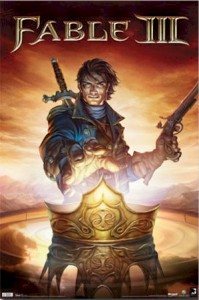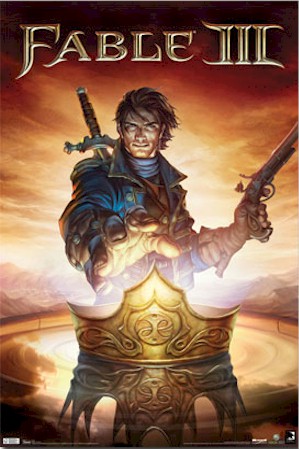by Chelsea Thornton (Staff Writer)
Email: cascade.arts[at]ufv[dot]ca
 The third instalment in the Fable series was awaited with all the impatience you would expect to see surrounding a new release in such a much-loved series. Calendars were marked, days were counted down, and special editions were purchased. And then, on October 26th, Fable III arrived.
The third instalment in the Fable series was awaited with all the impatience you would expect to see surrounding a new release in such a much-loved series. Calendars were marked, days were counted down, and special editions were purchased. And then, on October 26th, Fable III arrived.
The new release stays true to the basic principle of the previous Fable games: the player works towards the defeat of an arch-villain while making decisions which impact the morality of the player. The plot, however, is a definite departure from the previous instalments. For the first time, the player does not experience the childhood of their character, and the game begins during the character’s adolescence. Also, this hero is not the poor, socially oppressed orphan of previous Fable stories; you assume the role of prince or princess, destined to overthrow your king of a brother. You are not a one man army, and your progress through the first part of the game centres on recruiting forces for a revolution.
The Albion of Fable III is an industrial-era world, recalling Dickensian London in setting and revolutionary France in spirit. It is easily the most socially conscious Fable we have encountered so far, and this social consciousness is woven into the game play: the challenges of the second half of the story are, for the most part, politically-based, instead of action-based. Perhaps reflecting the powerful presence of the real-world economic situation in our social consciousness, the second half of the story is about finances, balancing the economic health of the country with its social health.
The game still does offer up plenty of action and combat. Many of Fable’s classic adversaries return for this instalment. The Albion of Fable III is populated with Hobbes, Hollowmen, Bandits (rebranded as Mercenaries) and Balverines. Also, the natural world has taken on new menace, with wolves, bats and birds all capable of engaging in combat with the player. The fight sequences are interspersed with short cut-scenes that correspond to flourishes in combat – slow motion re-enactments of your character’s battle prowess.
The biggest innovation in the game comes from the complete removal of lists from the game. The lists are replaced by graphic representations of the player’s items: clothing and styling options in the dressing room, trophies and treasure in the treasury and weapons in the armoury, all of which are housed within the hero’s Sanctuary, which replaces the main menu. You even access your dog’s status by viewing his dog bed. The goal in translating the lists into physical representations was to create a sense of more fluid game play; the player never leaves the visual reality of the world, and should feel as though the action is more continuous. Although this new menu is more continuous visually, it takes more time to navigate through your inventory, and the set-up is less instinctual than the classic list version.
The visual rendering of the new Albion is outstanding: the creators have maintained the richness of previous settings and taken full advantage of current graphics potential to make the world crisper, more realistic and more beautiful than ever before. The water in Fable III is the real stand-out, allowing glimpses of the landscape underneath the surface.
Fable III should please fans of the franchise. It references many characters and places from previous versions, but also provides a fresh plot, managing to avoid becoming a repetition of the series’ past adventures.


